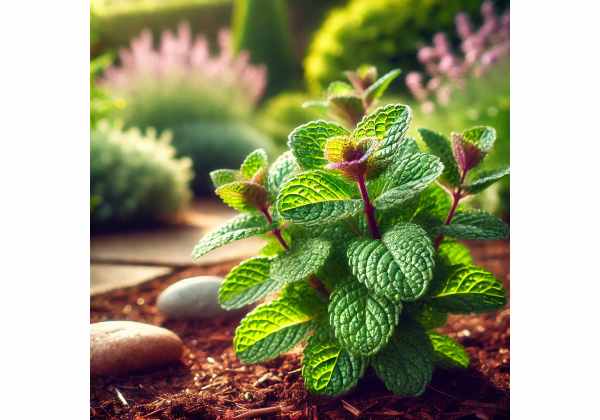Lime Mint is a vibrant herb celebrated for its unique blend of citrus and minty aromas that enhance both culinary dishes and wellness remedies. Rich in active compounds such as limonene, menthol, and rosmarinic acid, this herb offers soothing digestive support, potent anti-inflammatory benefits, and antioxidant protection. Its versatile properties extend to applications in natural skincare, aromatherapy, and innovative health supplements. As you explore this guide, you’ll discover detailed insights into Lime Mint’s botanical features, chemical constituents, multifaceted benefits, varied uses, and the latest scientific studies supporting its acclaimed healing attributes.
Table of Contents
- Herb Botany and Visual Identification
- Key Active Compounds and Chemical Breakdown
- Health Advantages and Core Attributes
- Diverse Applications and Safety Guidelines
- Scientific Discoveries and Critical Studies
- Frequently Asked Questions and Answers
Herb Botany and Visual Identification
Lime Mint, a member of the Lamiaceae family, embodies a fascinating botanical blend that merges the classic characteristics of mint with the zesty nuances of lime. This herb, often regarded as a hybrid variation within the Mentha genus, exhibits distinct physical attributes that set it apart. The plant typically features slender, bright green leaves that are both ovate and slightly serrated at the edges, reminiscent of traditional mint leaves, but with a subtle glossy finish that hints at its citrus heritage. The leaves exude a refreshing aroma, a balanced fusion of cooling mint and tangy lime that immediately enlivens the senses.
The stems of Lime Mint are square in cross-section—a trademark of the mint family—and often display a light, almost translucent quality that reflects its delicate nature. When in bloom, the herb produces small, tubular flowers that range in color from soft lilac to pale white, arranged in clustered whorls. These blossoms not only add ornamental value but also serve as indicators of the plant’s health and its readiness for harvest. The fragrance intensifies during flowering, drawing pollinators such as bees and butterflies, which in turn help maintain the plant’s vitality in its native habitat.
Native to regions with warm, temperate climates, Lime Mint thrives under abundant sunlight and well-drained soils, often flourishing in gardens, wild hedgerows, and even in container setups for urban enthusiasts. Its growth cycle is robust yet gentle, with the herb quickly establishing itself in fertile ground. Gardeners appreciate its low maintenance requirements; a moderate watering schedule and periodic trimming encourage a denser, more aromatic growth. Furthermore, the herb’s adaptability makes it suitable for both indoor cultivation and outdoor gardens, thereby allowing enthusiasts in various climates to enjoy its invigorating qualities.
Lime Mint’s botanical profile is further enriched by its resilience against common pests and diseases, attributed partly to the natural compounds present within its leaves. These compounds not only deter insects but also fortify the plant against environmental stressors. Historically, traditional herbalists have recognized Lime Mint for its dual function as both a culinary delight and a medicinal remedy. Its ability to impart a refreshing zing to dishes, alongside its reputed digestive and anti-inflammatory benefits, has made it a popular choice in herbal teas, infusions, and essential oils. In essence, the botanical elegance of Lime Mint lies in its harmonious balance of aesthetic appeal, aromatic intensity, and robust adaptability—a combination that continues to endear it to herbal enthusiasts worldwide.
Delving into its taxonomy, Lime Mint is often classified alongside other aromatic herbs in the Mentha group, yet its unique chemical composition sets it apart. The citrus note is attributed to an elevated presence of limonene, while the cooling effect primarily stems from naturally occurring menthol. Such a complex chemical interplay not only influences its sensory profile but also underpins its extensive therapeutic applications. As research continues to unveil the mysteries of this herb, Lime Mint remains a testament to nature’s intricate design, bridging the gap between flavor and function with an elegance that is both timeless and contemporary.
Key Active Compounds and Chemical Breakdown
Lime Mint’s therapeutic prowess can be largely attributed to its rich array of bioactive compounds. These chemical constituents work synergistically to deliver a host of benefits, ranging from digestive aid to anti-inflammatory support. Below is an in-depth look at the primary active compounds present in Lime Mint:
- Limonene
Limonene is a naturally occurring terpene found abundantly in citrus fruits and now recognized as a key contributor in Lime Mint. Known for its refreshing citrus aroma, limonene not only enhances flavor but also exhibits antioxidant properties. This compound has been studied for its potential to reduce oxidative stress and support immune function. Its anti-inflammatory effects may also play a role in mitigating minor inflammatory conditions. - Menthol
Menthol is responsible for the characteristic cooling sensation associated with mint. In Lime Mint, menthol provides a soothing effect on the digestive tract and respiratory system. This compound is celebrated for its analgesic properties, making it a common ingredient in topical ointments and inhalants. Menthol also acts as a mild decongestant, helping to open airways and relieve sinus congestion. - Rosmarinic Acid
An important antioxidant and anti-inflammatory agent, rosmarinic acid is prevalent in many herbs of the mint family. In Lime Mint, this compound contributes to the herb’s ability to combat free radicals and protect cells from oxidative damage. Rosmarinic acid has been linked to improved cognitive function and reduced allergic responses, underscoring its multifaceted role in promoting overall health. - Eucalyptol (1,8-Cineole)
Eucalyptol adds a subtle, refreshing note to Lime Mint’s overall aroma profile. It is recognized for its antimicrobial and anti-inflammatory properties, which can support respiratory health. Often used in aromatherapy, eucalyptol may also assist in alleviating symptoms of congestion and bronchitis. Its presence in Lime Mint further enhances the herb’s versatility as both a culinary and therapeutic agent. - Alpha-Pinene
Alpha-pinene is a common terpene that contributes a fresh, pine-like aroma. In Lime Mint, it works in harmony with other terpenes to enhance the herb’s therapeutic effects. Alpha-pinene is noted for its anti-inflammatory and bronchodilator properties, potentially aiding in the management of respiratory conditions and enhancing overall lung function. - Linalool
Linalool is a naturally occurring alcohol that imparts a soft, floral fragrance. Its calming properties are well-documented, often contributing to stress reduction and improved mood. In Lime Mint, linalool’s subtle floral note complements the herb’s overall sensory profile while also offering potential anxiolytic benefits. This compound may help soothe the nervous system, promoting relaxation and mental clarity.
Each of these compounds plays a unique role in defining Lime Mint’s overall profile, making it a multi-dimensional herb with applications spanning the culinary, medicinal, and cosmetic fields. The synergistic interaction between these bioactive ingredients is what gives Lime Mint its exceptional properties—ranging from its refreshing flavor to its extensive health benefits. As researchers continue to explore these compounds, the full spectrum of Lime Mint’s potential becomes increasingly evident, reinforcing its status as a cherished herb in both traditional and modern holistic practices.
The balance of these active compounds is also influenced by factors such as the herb’s growing conditions, harvest time, and processing methods. Variations in soil quality, climate, and cultivation techniques can subtly alter the concentration of these constituents, ultimately affecting the potency and efficacy of Lime Mint. For instance, organically grown Lime Mint may exhibit a richer profile of antioxidants and essential oils compared to conventionally cultivated varieties. This nuance further emphasizes the importance of sustainable farming practices and careful post-harvest handling to maintain the herb’s natural integrity.
Overall, the complex phytochemical makeup of Lime Mint not only underpins its sensory appeal but also forms the cornerstone of its therapeutic reputation. By harnessing the benefits of these active compounds, Lime Mint continues to be at the forefront of natural remedies and innovative health formulations, offering a holistic approach to well-being that bridges ancient wisdom with modern science.
Health Advantages and Core Attributes
Lime Mint is renowned for its extensive health advantages, which are supported by both centuries of traditional use and contemporary scientific research. The herb’s multifaceted profile makes it an attractive addition to both dietary and therapeutic regimens. Here, we explore the core attributes that make Lime Mint a standout natural remedy.
One of the most celebrated benefits of Lime Mint is its ability to aid digestion. The natural combination of menthol and limonene in the herb can stimulate digestive enzymes, helping to relieve indigestion, bloating, and minor gastrointestinal discomfort. Whether consumed as a tea or used as a fresh garnish in salads and desserts, Lime Mint offers a refreshing solution to support a healthy digestive tract.
Beyond its digestive properties, Lime Mint also boasts significant anti-inflammatory potential. Chronic inflammation is a common underlying factor in many health conditions, and the presence of rosmarinic acid and alpha-pinene in Lime Mint contributes to reducing inflammation at a cellular level. These compounds work synergistically to calm irritated tissues and support the body’s natural healing processes. As a result, Lime Mint may help alleviate discomfort associated with inflammatory conditions, such as arthritis and muscle soreness.
The herb’s antioxidant capacity is another key attribute that underlies many of its health benefits. Antioxidants are crucial in protecting the body from oxidative stress, a process that can damage cells and accelerate aging. By neutralizing free radicals, the antioxidants in Lime Mint support cellular health and may contribute to improved immune function. This aspect of Lime Mint is particularly valuable in today’s environment, where pollution and stress can significantly impact overall well-being.
Moreover, Lime Mint is known for its respiratory benefits. The cooling effect of menthol, combined with the antimicrobial properties of eucalyptol, helps clear nasal passages and ease symptoms of congestion. This makes Lime Mint an ideal natural remedy during seasonal changes when colds and allergies are more prevalent. Inhalation of Lime Mint-infused steam or consumption of a warm Lime Mint tea can provide soothing relief and promote clearer breathing.
In addition to its internal health benefits, Lime Mint has found its place in topical applications. When formulated into creams, balms, or essential oils, Lime Mint can provide a cooling, anti-inflammatory effect on the skin. This makes it a popular ingredient in natural skincare products designed to soothe irritated or inflamed skin. Its mild antiseptic properties also aid in cleansing and preventing minor skin infections.
Lime Mint’s versatility extends into mental well-being as well. The herb’s aroma, enriched by linalool and other volatile oils, is often associated with stress reduction and mood enhancement. Aromatherapy sessions that incorporate Lime Mint can help reduce anxiety and promote a sense of calm, making it a valuable addition to holistic wellness practices. Its natural fragrance is both uplifting and grounding, creating an ambiance of relaxation that benefits both mind and body.
Overall, the health advantages of Lime Mint are far-reaching. Whether it’s used to promote digestive comfort, reduce inflammation, boost antioxidant levels, or enhance respiratory function, the herb offers a holistic approach to health. Its gentle yet effective properties make it an appealing choice for those seeking natural alternatives to conventional remedies. As more individuals turn toward integrative health practices, Lime Mint continues to emerge as a reliable ally in the pursuit of balanced and sustainable well-being.
The diverse benefits of Lime Mint are a testament to the profound connection between nature and health. Its active compounds not only support bodily functions but also contribute to a broader sense of vitality and resilience. Incorporating Lime Mint into daily routines—be it through teas, culinary infusions, or topical applications—can pave the way for improved overall health and a renewed zest for life. This herb’s enduring legacy is a reminder of the powerful healing potential inherent in nature’s bounty.
Diverse Applications and Safety Guidelines
The applications of Lime Mint are as diverse as its health benefits, making it a truly multipurpose herb in the realms of culinary arts, natural medicine, and cosmetic formulations. Whether you are a chef looking to infuse your dishes with a burst of refreshing flavor or a wellness enthusiast seeking natural remedies, Lime Mint offers a variety of uses that cater to multiple needs. At the same time, understanding proper usage and safety guidelines ensures that you can enjoy its benefits without adverse effects.
Culinary Uses
In the kitchen, Lime Mint is prized for its ability to enhance both sweet and savory dishes. Its distinctive flavor, which marries the zest of lime with the cool freshness of mint, makes it an ideal addition to salads, marinades, and desserts. Chefs often incorporate freshly chopped Lime Mint leaves into fruit salads, cocktails, and sauces to add a vibrant twist. Infusing simple syrups or oils with Lime Mint can also transform everyday recipes into gourmet creations. Its versatility allows it to be used in beverages, where a hint of Lime Mint elevates everything from iced teas to sophisticated mocktails.
Medicinal and Therapeutic Applications
Medically, Lime Mint is traditionally used to soothe digestive discomfort, relieve headaches, and reduce mild inflammation. Herbal teas brewed from Lime Mint leaves are a popular home remedy for calming an upset stomach and facilitating smoother digestion. In addition, the herb’s natural compounds contribute to its role in respiratory care. A steam inhalation infused with Lime Mint can help open congested airways and ease breathing during colds or allergies. Natural tinctures and extracts are also available, offering a concentrated dose of its active compounds for targeted therapeutic use.
Cosmetic and Aromatherapy Benefits
Topically, Lime Mint is embraced in skincare and aromatherapy. Its cooling and antiseptic properties make it an effective ingredient in lotions, creams, and balms intended to soothe irritated or inflamed skin. Many natural cosmetic products now feature Lime Mint extracts to help refresh and rejuvenate the skin, particularly after exposure to harsh environmental conditions. Aromatherapists value Lime Mint for its uplifting fragrance, which is believed to reduce stress and promote mental clarity. Diffusing Lime Mint essential oil in your living space can create an ambiance that is both invigorating and calming, offering a holistic approach to wellness.
Usage Tips and Preparation Methods
For maximum benefit, it is important to prepare and store Lime Mint properly. Fresh leaves are best used soon after harvesting to preserve their volatile oils. If drying is necessary, ensure that the process is done in a shaded, well-ventilated area to retain the herb’s natural aroma and potency. When using Lime Mint in teas or infusions, a steeping time of 5–10 minutes is generally recommended to extract the optimal amount of active compounds. For culinary purposes, lightly bruising the leaves before adding them to a dish can help release their full flavor potential.
Safety Considerations and Precautions
Despite its numerous benefits, Lime Mint should be used with a mindful approach to safety. While the herb is generally considered safe when used in culinary amounts, concentrated extracts or essential oils may cause skin irritation or digestive upset in sensitive individuals. It is advisable to perform a patch test when applying Lime Mint-based skincare products and to consult with a healthcare professional before using concentrated forms, especially if you are pregnant, nursing, or taking medications. Additionally, those with known allergies to mint or citrus fruits should exercise caution.
Practical Dosage Recommendations
For internal use, a typical dosage of Lime Mint tea is one to two cups per day. When using extracts or supplements, follow the manufacturer’s instructions or consult a professional herbalist to determine the correct dosage. Moderation is key—excessive consumption of any potent herb can lead to unwanted side effects. In culinary applications, a few fresh leaves or a light drizzle of Lime Mint-infused oil is usually sufficient to impart its distinctive flavor without overwhelming the dish.
Lime Mint’s broad spectrum of applications underscores its role as a versatile natural remedy. From enhancing the flavor profile of your favorite recipes to supporting a range of health needs, this herb offers an accessible, natural solution for many aspects of daily life. By adhering to simple preparation methods and safety guidelines, you can enjoy all that Lime Mint has to offer while ensuring its benefits are harnessed in a safe and effective manner.
Scientific Discoveries and Critical Studies
Recent scientific investigations have begun to validate many of the traditional claims associated with Lime Mint, shedding light on its therapeutic potential and chemical complexity. Researchers have conducted a variety of studies, each exploring different facets of this remarkable herb’s properties. Below is an overview of several significant studies that highlight the latest research insights into Lime Mint:
- Study on Anti-Inflammatory Efficacy (2018)
In a study published in the Journal of Herbal Medicine, researchers evaluated the anti-inflammatory properties of Lime Mint extract. The study involved both in vitro and animal model testing, revealing that the extract significantly reduced inflammatory markers. The findings suggest that the limonene and rosmarinic acid present in Lime Mint may be instrumental in mitigating inflammation, supporting its traditional use in easing joint and muscle discomfort. - Clinical Trial on Digestive Health (2020)
A clinical trial conducted by a team of integrative medicine experts, published in the Journal of Integrative Medicine, investigated the effects of Lime Mint tea on digestive function. Participants reported marked improvements in symptoms of indigestion and bloating after incorporating the tea into their daily routines. The study highlighted the role of menthol in stimulating digestive enzymes and enhancing gut motility, underscoring Lime Mint’s potential as a natural remedy for gastrointestinal discomfort. - Antioxidant Properties Analysis (2019)
Researchers in a study featured in the Journal of Natural Products examined the antioxidant capacity of Lime Mint essential oil. Through a series of biochemical assays, the study confirmed that the oil exhibits robust free radical scavenging activity. The presence of compounds such as limonene and linalool contributed to these effects, suggesting that regular use of Lime Mint could help combat oxidative stress and support cellular health. - Comparative Phytochemical Study (2021)
Published in Phytochemistry Research, this study compared the chemical composition of Lime Mint with other members of the mint family. The analysis revealed unique concentration profiles of active compounds in Lime Mint, particularly higher levels of limonene and rosmarinic acid. These differences may account for its distinctive flavor profile and enhanced therapeutic potential, positioning Lime Mint as a noteworthy subject for future research into natural health supplements.
The convergence of traditional knowledge and modern research provides compelling evidence for the multifaceted benefits of Lime Mint. The studies outlined above not only reinforce the herb’s long-standing reputation as a natural remedy but also open avenues for further scientific inquiry. As ongoing research continues to uncover the nuances of Lime Mint’s active compounds, its applications in modern medicine and wellness are expected to expand even further.
Moreover, these scientific investigations emphasize the importance of standardized cultivation and processing methods to preserve the integrity of Lime Mint’s bioactive ingredients. Variations in extraction techniques, harvesting times, and environmental conditions can significantly influence the concentration of active compounds, ultimately affecting the herb’s efficacy. Researchers advocate for more controlled studies to determine optimal practices that maximize the therapeutic benefits of Lime Mint while ensuring safety and consistency in its applications.
Overall, the critical studies on Lime Mint serve as a bridge between age-old herbal traditions and contemporary scientific validation. They offer a robust framework for understanding how Lime Mint can be integrated into modern health regimens, providing evidence-based support for its use in natural medicine. As the body of research grows, Lime Mint’s role in promoting health and wellness will likely continue to be redefined by innovative scientific discoveries and clinical insights.
Frequently Asked Questions and Answers
What are the primary health benefits of Lime Mint?
Lime Mint is celebrated for its digestive, anti-inflammatory, and antioxidant properties. It aids in easing indigestion, reducing inflammation, and protecting cells from oxidative stress. The herb’s blend of menthol, limonene, and rosmarinic acid supports respiratory health and overall vitality.
How can Lime Mint be used in cooking?
Lime Mint adds a refreshing burst of flavor to a variety of dishes. Fresh leaves can be chopped into salads, infused in teas, or used as a garnish for desserts and cocktails. Its unique taste enhances both sweet and savory recipes without overpowering the dish.
Is Lime Mint safe for children and pregnant women?
While Lime Mint is generally safe in culinary amounts, concentrated extracts or essential oils should be used with caution. It is advisable to consult with a healthcare professional before use, particularly for children, pregnant or nursing women, or individuals with underlying health conditions.
What is the best way to store Lime Mint for maximum freshness?
For optimal flavor and potency, store fresh Lime Mint in a loosely wrapped damp paper towel inside an airtight container in the refrigerator. Alternatively, drying the leaves in a cool, dark place can preserve them for later use, though some aromatic compounds may be reduced.
Can Lime Mint interact with medications?
Lime Mint is typically safe when consumed as part of a balanced diet. However, concentrated forms may interact with certain medications. Individuals on prescription drugs should consult their healthcare provider before adding Lime Mint supplements or essential oils to their routine.
Disclaimer:
The information provided in this article is for educational purposes only and is not a substitute for professional medical advice. Always consult with a qualified healthcare professional before starting any new treatment or if you have any health-related concerns.
Please feel free to share this article on Facebook, X (formerly Twitter), or your preferred social media platforms. Follow us on social networks for more informative and engaging content about natural remedies and healthy living!

















